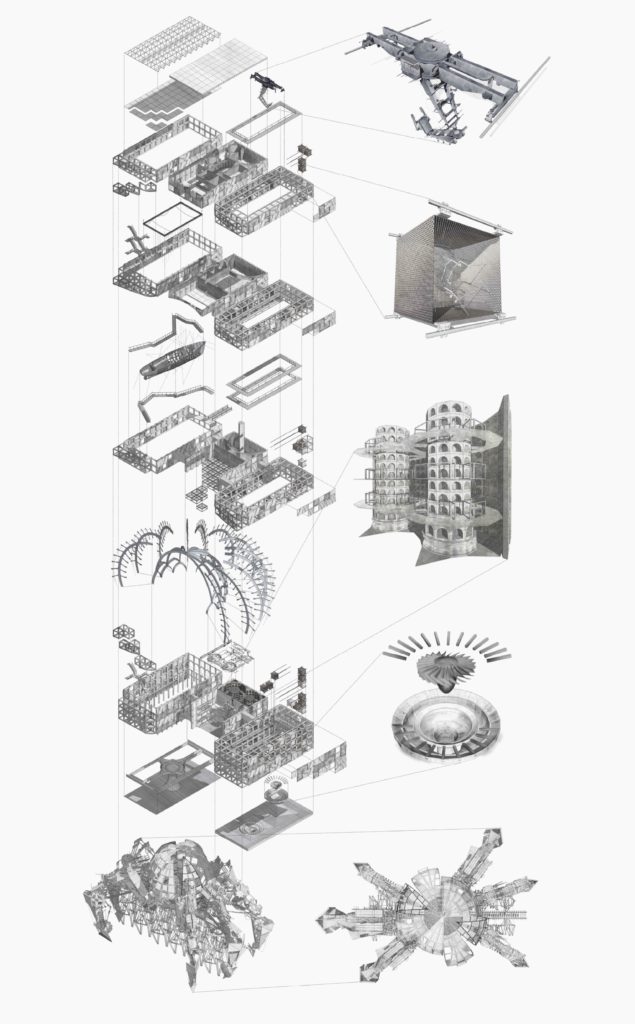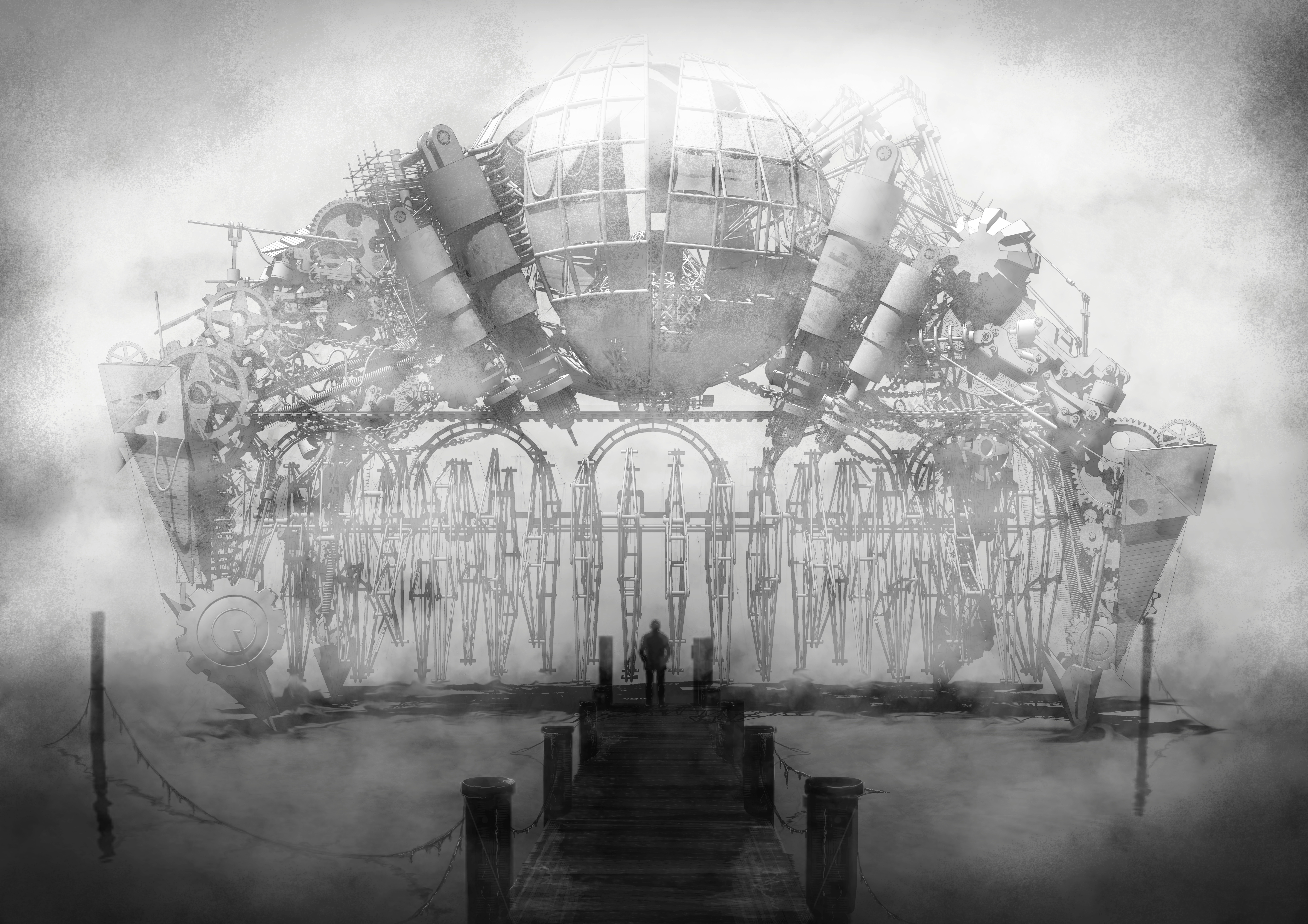“The Machine” Showcases the Atmospheric Power of Architectural Drawings

British architect Mandalika Justine Roberts scooped the Non-Student Winner title in the inaugural One Drawing Challenge with “The Machine: A Mechanical Mudlark”, a piece inspired by the modern day “Mudlark” treasure hunters of the River Thames in London. The drawing encapsulates the collision of man and machine, expressed through the historical narrative of scavenging. Roberts wins $2,500 and a collection of professional drawing tools, along with a well-deserved spotlight for her creation.
Roberts delivered an incredibly detailed, “hyper-engineered” machine that appears mystical and alive, yet robotic in nature. Each of its physical components serves a purpose, expressing just how calculated and meticulous Roberts was in designing “The Machine”. To understand more about the mind behind this award-winning drawing, we spoke with Mandalika Justine Roberts and got some great insight.

Mandy Roberts’ winning drawing “The Machine: A Mechanical Mudlark”
Nathaniel Bahadursingh: How did you imagine the intricate mechanical details of this imaginary machine? How much technical thought was put into its design?
Mandalika Justine Roberts: Technically speaking, the machine is designed around the existing technology of cutter suction dredgers, which are capable of a scope of work from land reclamation to riverbank protection. I’ve also been inspired by Dutch artist Theo Jansen’s ‘strandbeest’ kinetic sculptures, and blended these ideas in conjunction with the excavating mechanical ‘arms’ from the dredger.
This resulted in the brutish appearance of working machinery. It has an animalistic presence, but on closer inspection, it appears robotic. Whilst the technical details are plausible, I opted to weave this hyper-engineered concept into the scavenger narrative, focusing on man and machine interacting with architecture.

What were the primary challenges of conceiving your work, from forming the idea to the actual physical process of drawing?
Predictably, there were technical issues left, right and centre. I sat down with my grandfather, an ex-naval engineer, and the architect in me challenged him to ‘make it work’. He came to the conclusion this would cost too much, take too long and logistically not be fit for purpose!
Understandably, this enigma took many iterations. However, all the refining and redesigning allowed me to work to a final drawing which could best summarize and showcase the complexity of the project.

For your piece, why did you choose that specific illustration technique and format?
In order to best convey a sense of the sublime narrative, I chose to shroud the drawing in atmospheric fog. At first this went against by best instincts, as I had spent a lot of time 3D modeling, rendering and drawing the composition to then obscure a lot of that work. However, I’m delighted that the risk paid off. The black and white palette and framed vignette were chosen to emphasize the chiaroscuro drama.
Do you have any other work as conceptual as this?
In my work, I enjoy creating a balance between drawing fine-tuned orthographics and producing wildly unpredictable conceptual renderings. I’ve also designed another series which is based on a recent natural phenomena in Thanet, UK, where drastic environmental changes had a catastrophic effect on marine life. The project is a crab-apocalypse-inspired gluttonous seafood extravaganza, where restaurant meets theatre.

What connection does the theme of your work have to you and your experience?
For this particular project I was inspired by London’s Mudlarkers. I’d watch this community meander the Thames foreshore at low tide and they would later post their findings online. People from all walks of life would try and identify the artifacts, work out their potential value and historic symbolism.
I gave it a go myself, of course, and found nothing more than a discarded supermarket trolley, a spatula and a broken clay pipe. I hadn’t quite struck gold but this was my treasure all the same.

How did the process and workflow of creating this work compare to traditional architectural drafting?
The process and workflow were surprisingly similar. Granted, these are not your usual orthographics, however, the workflow was almost identical to that I use in practice. From precedents, to research, to sketching preliminary ideas; I developed a highly detailed 3D digital model from which I extracted 2D orthographics.
I worked in AutoCAD to produce line weights and from the 3D model, extracted texture, tone and shadow renders. All of these layers are then pieced together in Photoshop and accentuated with photo textures for depth and atmosphere. I did, in fact, go a step further in creating this drawing by reworking in digitally drawn elements to exude the fantasy grunge effect.

What one tip would you give students and architects looking to win next year’s One Drawing Challenge?
Be brave and be bold with the composition. Architectural narrative can speak volumes. I sought to address the question: if this complex project had a single cover image, what would it be?
Graphically speaking, the drawing doesn’t necessarily have to be the whole story; it can be compelling to leave the viewer asking questions so entice them with enough to want to read on. However, questions need answers, so be ready to provide the depth of research and thought behind the visual aspect. Curiosity can be powerful. It is, after all, what drove my imagination into fabricating what lies beneath the River Thames.

What does winning the 2019 One Drawing Challenge mean to you?
It is such a great honor to receive this. Until now I’ve not had the courage to enter a competition of this magnitude and it looks like I should cut my losses whilst I’m ahead! I’m hugely grateful to all those at Architizer.
The talent pool in this competition was extraordinary; it must have been a nightmare selecting the final few. What I’ll definitely take away from this experience is a sense of pride in my work, finally plucking up the courage to share my work online and a resolution to produce more competition-worthy drawings.
Check out every amazing winner and commended entry in the inaugural One Drawing Challenge here. Interested in participating next year? Register for updates on the 2020 edition of the competition now:
Register for the 2020 One Drawing Challenge
The post “The Machine” Showcases the Atmospheric Power of Architectural Drawings appeared first on Journal.
, Nathaniel Bahadursingh, read more Journal http://bit.ly/2N4yiAM
Yorumlar
Yorum Gönder